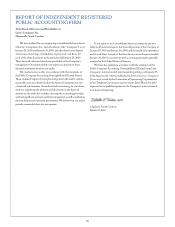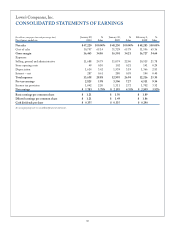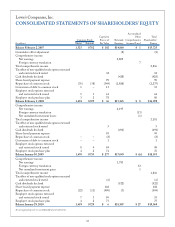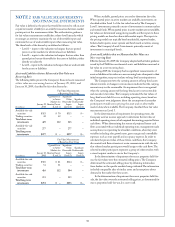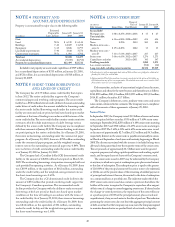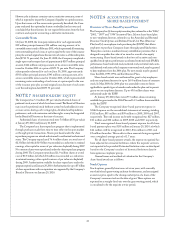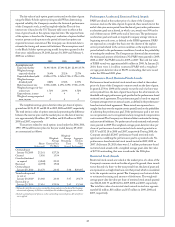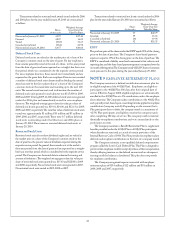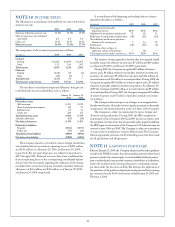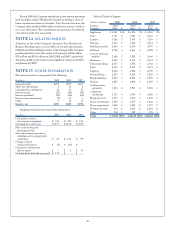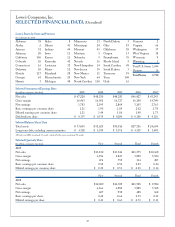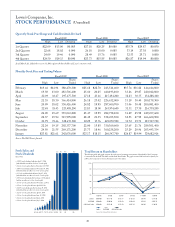Lowe's 2009 Annual Report Download - page 40
Download and view the complete annual report
Please find page 40 of the 2009 Lowe's annual report below. You can navigate through the pages in the report by either clicking on the pages listed below, or by using the keyword search tool below to find specific information within the annual report.
38
NOTE 2 FAIR VALUE MEASUREMENTS
AND FINANCIAL INSTRUMENTS
Fair value is defined as the price that would be received to sell an asset
or paid to transfer a liability in an orderly transaction between market
participants at the measurement date. e authoritative guidance
for fair value measurements establishes a three-level hierarchy which
encourages an entity to maximize the use of observable inputs and
minimize the use of unobservable inputs when measuring fair value.
e three levels of the hierarchy are defined as follows:
• Level 1 – inputs to the valuation techniques that are quoted
prices in active markets for identical assets or liabilities
• Level 2 – inputs to the valuation techniques that are other than
quoted prices but are observable for the assets or liabilities, either
directly or indirectly
• Level 3 – inputs to the valuation techniques that are unobservable
for the assets or liabilities
Assets and Liabilities that are Measured at Fair Value on a
Recurring Basis
e following tables present the Company’s financial assets measured
at fair value on a recurring basis as of January 29, 2010, and
January 30, 2009, classified by fair value hierarchy:
Fair Value Measurements
at Reporting Date Using
Quoted Prices Significant
in Active Other Significant
Markets for Observable Unobservable
January 29, Identical Assets Inputs Inputs
(In millions)
2010 (Level 1) (Level 2) (Level 3)
Available-for-sale
securities $383 $ 70 $313 $ –
Trading securities 42 42 – –
Total short-term
investments 425 112 313 –
Available-for-sale
securities 277 – 277 –
Total long-term
investments $277 $ – $277 $ –
Fair Value Measurements
at Reporting Date Using
Quoted Prices Significant
in Active Other Significant
Markets for Observable Unobservable
January 30, Identical Assets Inputs Inputs
(In millions)
2009 (Level 1) (Level 2) (Level 3)
Available-for-sale
securities $385 $ 81 $304 $ –
Trading securities 31 31 – –
Total short-term
investments 416 112 304 –
Available-for-sale
securities 253 – 253 –
Total long-term
investments $253 $ – $253 $ –
When available, quoted prices are used to determine fair value.
When quoted prices in active markets are available, investments are
classified within Level 1 of the fair value hierarchy. e Company’s
Level 1 investments primarily consist of investments in money market
and mutual funds. When quoted prices in active markets are not available,
fair values are determined using pricing models and the inputs to those
pricing models are based on observable market inputs. e inputs to
the pricing models are typically benchmark yields, reported trades,
broker-dealer quotes, issuer spreads and benchmark securities, among
others. e Company’s Level 2 investments primarily consist of
investments in municipal bonds.
Assets and Liabilities that are Measured at Fair Value on a
Non-recurring Basis
Effective January 31, 2009, the Company adopted authoritative guidance
issued by the FASB for non-financial assets and liabilities measured at
fair value on a non-recurring basis.
During 2009, the Company had no significant measurements of
assets or liabilities at fair value on a non-recurring basis subsequent to their
initial recognition, except as it relates to long-lived asset impairment.
e Company reviews the carrying amounts of long-lived assets
whenever events or changes in circumstances indicate that the carrying
amounts may not be recoverable. An impairment loss is recognized
when the carrying amount of the long-lived asset is not recoverable
and exceeds its fair value. e Company estimated the fair values of
long-lived assets held-for-use, including operating stores, based on
the Company’s own judgments about the assumptions that market
participants would use in pricing the asset and on observable
market data, when available. e Company classified these fair value
measurements as Level 3.
In the determination of impairment for operating stores, the
Company used an income approach to determine the fair value of
individual operating stores, which required discounting projected future
cash flows. When determining the stream of projected future cash
flows associated with an individual operating store, management made
assumptions, incorporating local market conditions, about key store
variables including sales growth rates, gross margin and controllable
expenses such as store payroll and occupancy expense. In order to
calculate the present value of those future cash flows, the Company
discounted cash flow estimates at a rate commensurate with the risk
that selected market participants would assign to the cash flows. e
selected market participants represent a group of other retailers with
a store footprint similar in size to the Company’s.
In the determination of impairment for excess properties held-for-
use, the fair values were the estimated selling prices. e Company
determined the estimated selling prices by obtaining information
from brokers in the specific markets being evaluated. e information
included comparable sales of similar assets and assumptions about
demand in the market for these assets.
In the determination of impairment for excess properties held-for-
sale, the fair values were the estimated selling prices, as determined for
excess properties held-for-use, less cost to sell.


